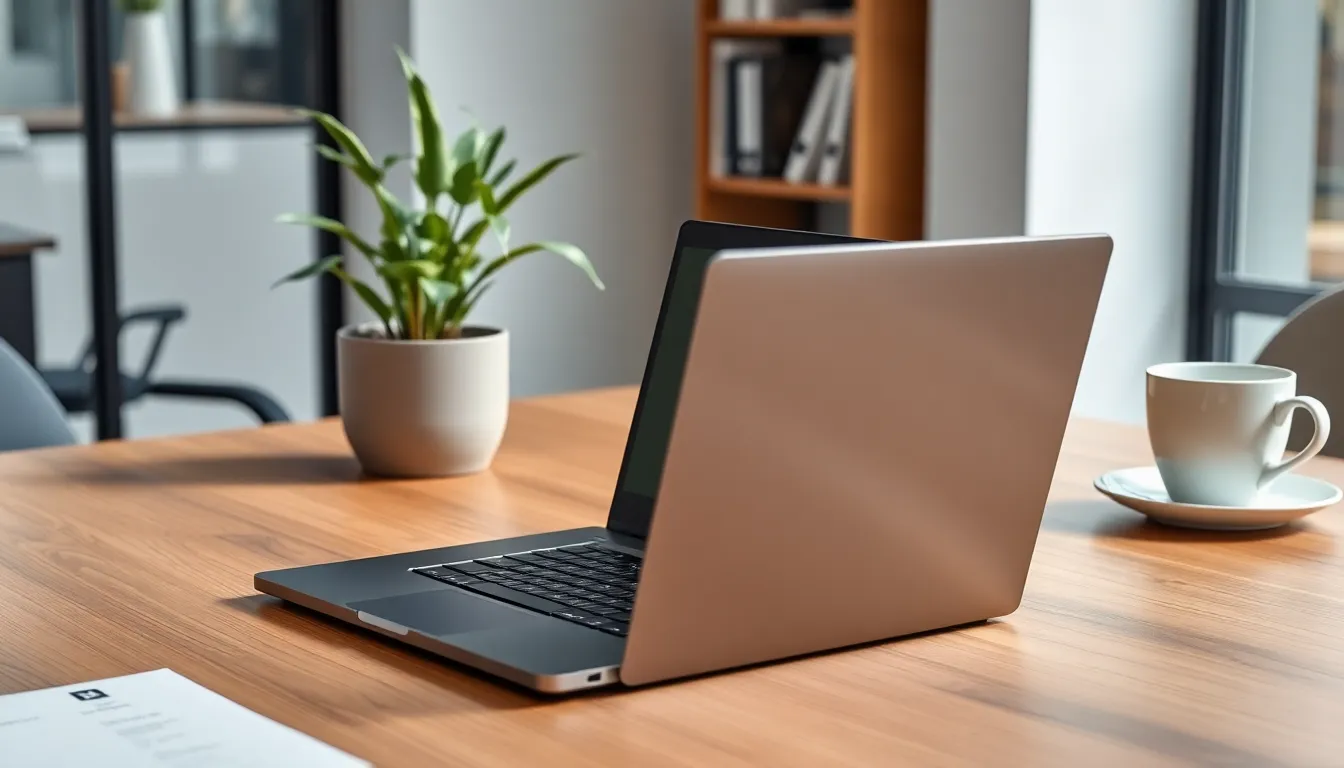Table of Contents
ToggleIn a world where mobility and performance reign supreme, ultrabooks have emerged as the go-to choice for professionals and tech enthusiasts alike. These sleek, lightweight laptops pack powerful hardware into a slim design, making them perfect for on-the-go productivity. With impressive battery life and rapid boot times, ultrabooks cater to the needs of users who demand efficiency without sacrificing style.
As technology continues to evolve, ultrabooks stand at the forefront, blending cutting-edge features with user-friendly interfaces. Whether it’s for work, school, or leisure, these devices offer a seamless experience that adapts to various lifestyles. Discover what makes ultrabooks a must-have in today’s fast-paced digital landscape and why they’re redefining the way people interact with technology.
What Are Ultrabooks?
Ultrabooks are sleek, lightweight laptops designed for portability without sacrificing performance. They cater to users seeking efficient computing power combined with modern aesthetics.
Key Features of Ultrabooks
- Thin and Lightweight Design: Ultrabooks typically measure less than 0.8 inches in thickness and weigh around 2 to 4 pounds, making them highly portable.
- High-Performance Hardware: Equipped with Intel’s Core i5 or i7 processors, ultrabooks provide fast processing capabilities. Many incorporate solid-state drives (SSDs) for quicker data access and improved speed.
- Long Battery Life: Ultrabooks often feature a battery life ranging from 8 to 15 hours, allowing users to work throughout the day without frequent charging.
- Rapid Boot Times: With advanced storage solutions, ultrabooks offer boot times under 10 seconds, enhancing overall productivity.
- High-Resolution Displays: Many ultrabooks boast Full HD (1920 x 1080) or 4K (3840 x 2160) displays, delivering sharp and vibrant visuals.
Differences Between Ultrabooks and Traditional Laptops
- Weight and Size: Ultrabooks are engineered for portability, whereas traditional laptops vary in weight, often exceeding 5 pounds and measuring more than 1 inch in thickness.
- Performance: Ultrabooks leverage high-end processors and SSDs, while traditional laptops might use slower hard drives and lower-end processors, which can impact speed and efficiency.
- Battery Life: The battery lifespan of ultrabooks extends beyond that of standard laptops, typically offering significantly more hours for continuous use.
- Build Quality: Ultrabooks utilize premium materials like aluminum and carbon fiber, in contrast to many traditional laptops that may consist of plastic casings.
- Price Point: Ultrabooks generally fall within a higher price range due to their advanced features, while traditional laptops often cater to various budget requirements.
Benefits of Using Ultrabooks

Ultrabooks offer numerous advantages, particularly for professionals and tech enthusiasts seeking efficiency and style. Their design and performance capabilities elevate the user experience significantly.
Portability and Design
Portability defines ultrabooks, which typically weigh less than 3 pounds and measure under 0.7 inches thick. Users can easily slip them into backpacks or briefcases, enhancing mobility. The sleek design often incorporates premium materials like aluminum or carbon fiber, contributing to durability while projecting a modern aesthetic. Ultrabooks also feature edge-to-edge displays that maximize screen real estate, providing an attractive interface for work or entertainment.
Battery Life and Performance
Battery life ranges from 8 to 15 hours, allowing users to work throughout the day without frequent recharging. Meanwhile, ultrabooks house high-performance hardware, commonly featuring Intel’s Core i5 or i7 processors, ensuring quick processing speeds for demanding applications. Users experience rapid boot times, typically under 10 seconds, resulting in increased productivity. This combination of energy efficiency and powerful performance makes ultrabooks suitable for both intensive tasks and casual use.
Popular Ultrabook Models
Several ultrabook models stand out in the market, showcasing superior performance, innovative features, and attractive designs. Key brands and notable models provide options for various user preferences.
Top Brands to Consider
- Dell
Dell’s XPS series features InfinityEdge displays, offering virtually borderless screens. Known for build quality and performance, XPS 13 and XPS 15 are popular choices.
- HP
The HP Spectre x360 combines elegance with versatility, boasting a convertible design. The Spectre x360 series often emphasizes long battery life and stunning visuals.
- Apple
MacBook Air is a leading model in the ultrabook category, celebrated for its Retina display and seamless integration with the Apple ecosystem. The latest models focus on performance improvements and battery efficiency.
- Lenovo
Lenovo’s ThinkPad X1 Carbon is renowned for its business-oriented features, including a comfortable keyboard and robust security options. This model often attracts professionals and enterprise users.
- Asus
Asus ZenBook series is recognized for its thin profile and powerful hardware. Models like ZenBook 13 deliver high-resolution displays and impressive battery life.
Comparisons of Notable Models
| Model | Weight | Battery Life | Processor | Display |
|---|---|---|---|---|
| Dell XPS 13 | 2.8 lbs | Up to 12 hours | Intel Core i7 | 13.3″ 4K UHD |
| HP Spectre x360 | 2.88 lbs | Up to 15 hours | Intel Core i7 | 13.3″ FHD OLED |
| Apple MacBook Air | 2.8 lbs | Up to 18 hours | Apple M1 chip | 13.3″ Retina |
| Lenovo ThinkPad X1 | 2.49 lbs | Up to 15 hours | Intel Core i7 | 14″ UHD |
| Asus ZenBook 13 | 2.5 lbs | Up to 14 hours | Intel Core i7 | 13.3″ FHD |
Notable models, such as Dell XPS 13 and HP Spectre x360, deliver lightweight designs while maintaining high performance. The Apple MacBook Air stands out with its exceptional battery life, making it attractive for all-day use. Users benefit from choosing models that match their specific needs, whether that involves premium displays or powerful processing capabilities.
Considerations Before Buying an Ultrabook
Several factors influence the choice of an ultrabook. Recognizing key elements ensures a purchase that meets user needs.
Budget and Pricing
Budget remains a crucial consideration. Ultrabooks generally range from $800 to $2,500, with premium models costing more due to advanced features. Users should establish a price range before browsing options. Assessing long-term value against initial cost helps identify the best fit. Discounts and seasonal sales often provide opportunities for budget-conscious buyers to secure high-quality ultrabooks at lower prices.
Hardware Specifications to Look For
Hardware specifications significantly impact performance and user experience. Key specifications to evaluate include:
- Processor Type: Intel Core i5 or i7 processors deliver optimal performance for multitasking and demanding applications.
- RAM Size: A minimum of 8 GB of RAM is recommended, with 16 GB providing increased efficiency for intensive tasks.
- Storage Type: Solid State Drives (SSD) offer faster boot times and data access compared to traditional Hard Disk Drives (HDD).
- Display Quality: High-resolution displays (1080p or higher) enhance clarity. Touchscreen capabilities also enhance usability.
- Battery Life: Look for models with a minimum of 8 hours of battery life to ensure productivity throughout the day.
Evaluating these specifications ensures alignment with personal usage patterns and expectations.
Ultrabooks have firmly established themselves as essential tools for modern professionals and tech enthusiasts. Their blend of portability performance and style makes them a standout choice for anyone needing reliable computing on the go. With impressive battery life and rapid boot times ultrabooks cater to those who value efficiency in their daily tasks.
As technology continues to evolve ultrabooks are likely to incorporate even more innovative features enhancing their appeal. Whether for work school or leisure these sleek devices offer a versatile and enjoyable user experience. Investing in an ultrabook means choosing a device that meets the demands of today’s fast-paced digital landscape while reflecting a commitment to quality and design.








